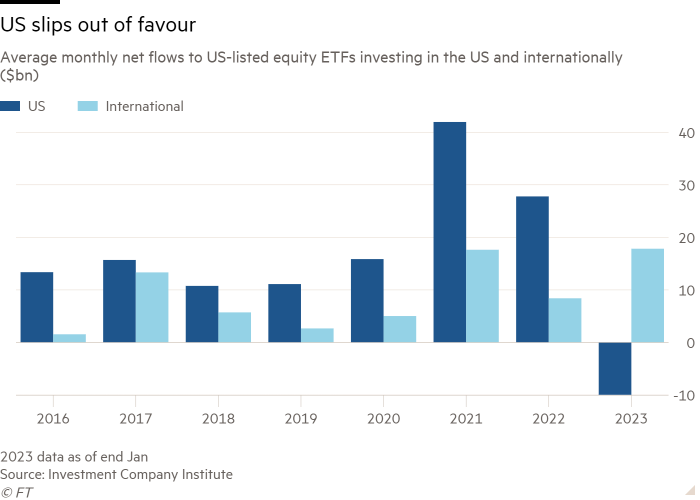US investors dump domestic equity ETFs for overseas funds

Simply sign up to the Exchange traded funds myFT Digest -- delivered directly to your inbox.
US investors appear to be losing faith in their own stock market and pumping money into overseas bourses.
The move represents a sharp about-turn for Americans, who have traditionally favoured Wall Street stocks by a wide margin, over and above the 60 per cent of global stock market capitalisation the US accounts for.
“[US] Investors came into the new year with a renewed focus on expanding their presence in European and Asian markets,” said Todd Rosenbluth, head of research at VettaFi, a New York-based consultancy.
“They have not been penalised for having a home bias in recent years because the fastest-growing companies were in the US, but sentiment has been shifting towards global diversification.”
Investors withdrew a net $10bn from US-listed exchange traded funds focused on US stocks during January, according to data from the Investment Company Institute, a trade body.
This was the second-largest monthly outflow from domestic equity funds since January 2019 and the eighth-largest in the past decade.
At the same time, US investors poured a net $17.8bn into overseas equity ETFs, the largest monthly flow for a year.

The gulf between flows to US and foreign equity funds was the fourth largest in the past 10 years, analysis of the ICI data shows.
The turnround is also sudden. Last year domestically focused US-listed equity ETFs took in a net $333bn, more than three times the $101bn attracted by foreign equity ETFs, with US funds maintaining a healthy lead as recently as December.
Nate Geraci, president of The ETF Store, said one driver had been the “fairly significant relative outperformance” of overseas markets in recent months.
Since the start of October, the MSCI EAFE index, which tracks developed stock markets outside North America, has risen 29 per cent, the MSCI China index 28.5 per cent and the MSCI Emerging Markets index 19.1 per cent, all ahead of the 14.8 per cent gain of the S&P 500. Over the same period the dollar, as measured by the DXY index, has fallen by 9.7 per cent.
“It’s notable that this outperformance coincides with US dollar weakness, which tends to serve as a key catalyst for international equity strength,” Geraci added. “Another tailwind has been the underlying sector composition of international markets, which aren’t as tethered to technology companies and instead favour areas such as financials.”
“We have seen signs of relative strength in the economic data coming out of Europe,” said Rosenbluth. “We have seen China beginning to reopen and US investors have embraced portfolio diversification.
“They have been adding to international equity strategies. They are willing to take on more risk in 2023 than they were in 2022.”
The foreign buying appears to be geographically diffuse, rather than centred on a single country or region. Data from Citi suggest emerging markets took in a little more than non-US developed market ETFs last month, while US large-cap growth ETFs accounted for the bulk of domestic outflows.
JPMorgan’s BetaBuilders Europe ETF (BBEU) topped the net flows leaderboard in January, pulling in $3.5bn, according to data from VettaFi.
Elisabeth Kashner, director of global fund analytics at FactSet, said “the most likely explanation”, both for rising US flows to Europe in general and BBEU in particular, is that JPMorgan’s army of wealth and private bank strategists “have started recommending the region”.
FactSet data indicate that JPMorgan-directed accounts currently hold about 88 per cent of BBEU’s shares.
Other winners, according to VettaFi, have been the iShares Core MSCI Emerging Markets ETF (IEMG), which has sucked in $3.2bn, the Vanguard FTSE Emerging Markets ETF (VWO), which has sucked up $770mn, and the Vanguard FTSE Developed Markets ETF (VEA).
Some believe this trend has further to run.
“International [ie non-US] stocks as a whole have substantially underperformed for the better part of the past decade-plus. There’s now some optimism that this cycle might finally be ending and international stocks could be poised to offer some value-add to portfolios,” said Geraci.
“I believe this newfound optimism has some staying power and expect to see international equity ETF inflows continue accelerating.”
Rosenbluth was also upbeat.
“I think it can run,” he said. “The expectation is that global inflation slows down, investors are willing to take on more risk and US investors look outside their home market.
“As long as the funds continue to perform well, I think this trend has the potential for legs. Investors feel that they are going to be rewarded for lower valuations [outside the US].”

Comments